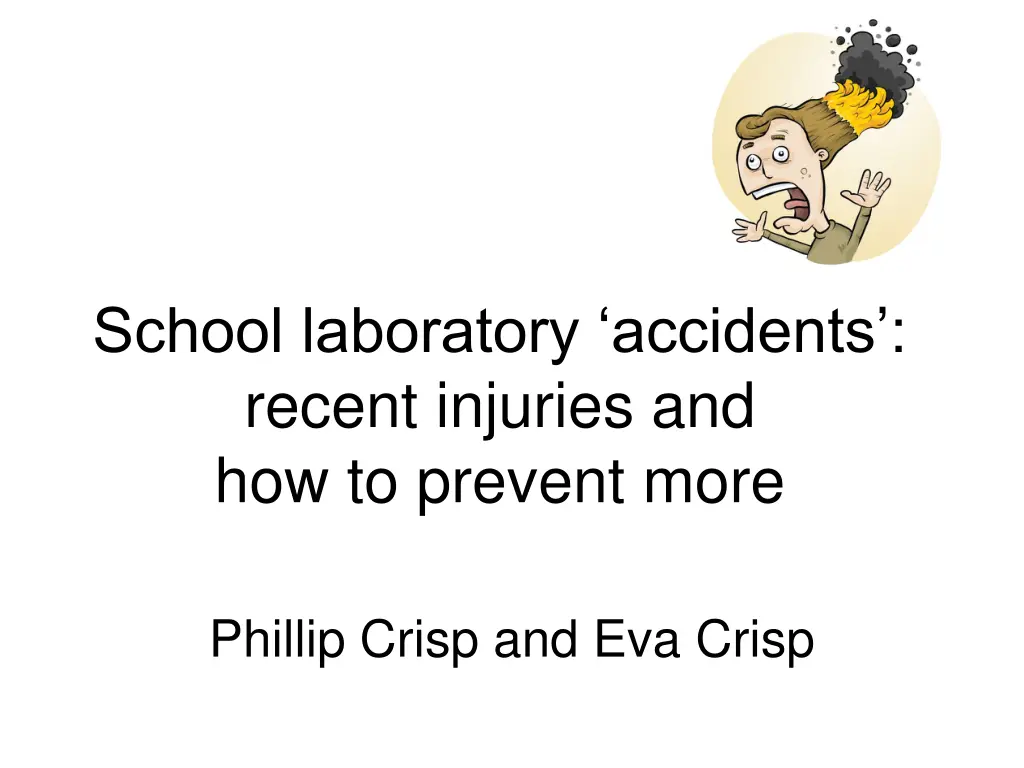
Preventing Laboratory Accidents: Recent Injuries and Safety Measures
Learn about common laboratory injuries such as burns, chemical exposure, and accidents with flammable substances. Discover how to prevent accidents and ensure safety in school laboratories to protect both students and staff.
Download Presentation

Please find below an Image/Link to download the presentation.
The content on the website is provided AS IS for your information and personal use only. It may not be sold, licensed, or shared on other websites without obtaining consent from the author. If you encounter any issues during the download, it is possible that the publisher has removed the file from their server.
You are allowed to download the files provided on this website for personal or commercial use, subject to the condition that they are used lawfully. All files are the property of their respective owners.
The content on the website is provided AS IS for your information and personal use only. It may not be sold, licensed, or shared on other websites without obtaining consent from the author.
E N D
Presentation Transcript
School laboratory accidents: recent injuries and how to prevent more Phillip Crisp and Eva Crisp
Most common laboratory injuries MAJOR methylated spirits fires hot water scalding chlorine, sulfur dioxide inhalation sodium hydroxide in eyes biological: extreme allergies, blood MINOR acids/alkalis on skin (or in eyes) heat burns, esp. Bunsen cuts, esp. broken glass
Flammable liquids methylated spirits e.g. steam engine chlorophyll extraction * coloured flames (MCln, borates) Others petrol and liquid hydrocarbons acetone Bunsen burner on safety = ignition source Tools (e.g. angle grinder) = ignition source *
Flammable solids sulfur e.g. plastic sulfur * paper e.g. student ignition in Bunsen Others charcoal blocks * sulfur + KClO3 * gummy bear + KClO3*
Flammable gases Town gas e.g. whole building explosion * leak from fitting/Bunsen Hydrogen e.g. Na + water * Al + NaOH(aq) * LPG e.g. leaks from fittings (barbeque) LPG + O2*
Toxic gases sulfur dioxide e.g. heating sulfur * chlorine e.g. bleach + acid (e.g. coca cola) * ammonia, e.g. spills bromine + hexene * iodine vapour
Corrosive chemicals alkalis e.g. NaOH, concentrated and hot * acids e.g. H2SO4, conc (carbon+soda snakes) * HCl, conc ammonia e.g. conc NH3
Hot objects Bunsen burner + tripod + gauze e.g. numerous minor burns hot beakers, flasks, test tubes e.g. numerous minor burns hot glass rods/tubing, wires, crucibles e.g. flame tests, glass working hot plates e.g. burns to forearm thermite reaction *
Cold burns dry ice e.g. prolonged skin contact * liquid nitrogen e.g. prolonged skin contact * asphyxiation * Don t drink! *
Scalding liquids Beaker of liquid on tripod & gauze e.g. major burns; easy to knock over Liquid ejected from test tube e.g. minor or major burns
Biological extreme allergies e.g. nuts * (Epipen training, avoid peanut oil, etc) human blood e.g. blood group testing * animal bites microbiology: contamination, flames
FIRST AID FOR corrosive chemicals on skin or in eyes heat burns and scalds APPLY COLD WATER Flush skin, eyes until chemical removed or for at least 20 minutes for burns (exceptions: benzene, HF) If significant incident, follow emergency procedures without delay
Perspective Manual handling injuries cause most days off work Extreme allergies, especially to nuts cause life-threatening situations Motor vehicle accidents (bus, parent vehicle) cause severe injuries Laboratory injuries are significant and nearly all can be prevented.
Accidents don t just happen! *
Burns to student Incorrect first aid Large volume of methylated spirits Flame apparently extinguished Almost colourless flame Teacher not trained Students not trained Inexperienced teacher No fire blanket Container too large Inadequate labelling No risk assessment Inadequate training Non-compliance with law
How to spot dangers Untrained people doing things Failure to assess risks Disorganised workplace Change without preparation . . . . . .
How to prevent an accident Understand the potential hazards associated with equipment, chemicals and biological/food items Carry out a risk assessment before you do anything! Introduce control measures: 1. Protect against likely problems (e.g. tray beneath) 2. Physically protect the work area (e.g. fume cupboard) 3. Protect yourself (e.g. safety glasses, gloves) Know emergency procedures and first aid RiskAssess can help!
RiskAssess demonstration






















